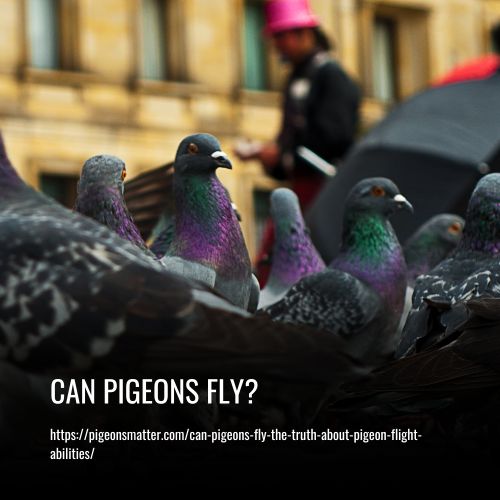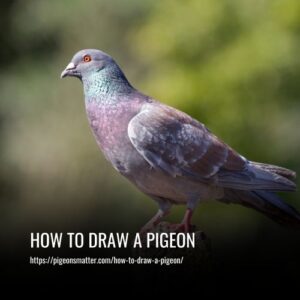Yes, pigeons are capable of flying. They are known for their ability to fly long distances and navigate their way back home.

How Far Can Pigeons Fly?
Pigeons are impressive flyers that can travel long distances, with some species capable of flying up to 600 miles at a time. The distance a pigeon can fly depends on its breed, size, and age, but many species have been observed covering hundreds of kilometers in search of food or for migration purposes.
Carrier pigeons were famously used during World War I to deliver crucial messages across enemy lines, flying over 160 kilometers in a single journey. Racing pigeons are also remarkable flyers, with the world record holder having flown a staggering 1,900 kilometers from Belgium to South Africa!
What sets pigeons apart is their homing instincts, which allow them to return to a specific location repeatedly. Homing pigeons have been trained by their owners to fly great distances and then return home without getting lost, making them invaluable for activities such as racing and communication throughout history.
In summary, pigeons are highly skilled flyers capable of covering vast distances quickly and accurately. While they may not be the fastest birds in flight, their ability to perform incredible feats makes them an impressive and fascinating species.
Overview of Wild Pigeons
Wild Pigeons are a unique and fascinating bird species that possess many impressive characteristics. They are easily identifiable by their grey-brown coloration and white markings on their wings and tail. Wild Pigeons are known for their incredible flying abilities, as they can travel for hundreds of kilometers in search of food or migration and can fly up to 100 km/h!
Their homing instinct is particularly impressive, as it allows them to find their way back home even after traveling hundreds of miles away. This instinct has been exploited by humans for centuries, using Wild Pigeons as messengers between rulers in ancient times.
Wild Pigeons have also been bred into a variety of shapes and sizes to suit different purposes. Racing pigeons, for example, are bred for their speed and endurance in long-distance races. Fancy breeds such as Indian Fantail Pigeons have colorful feathers and are bred for their aesthetic appeal.
Today, Wild Pigeons continue to be an important part of many cultures around the world. They can often be found congregating together in large flocks within cities. Despite their small size, these incredible birds continue to amaze us with their remarkable flying capabilities, reminding us of the power of nature.
1. Flying Ability of Wild Pigeons:
Wild Pigeons, also known as Columba livia, are remarkable birds with impressive flying abilities. They can reach speeds of up to 100 km/h and cover vast distances in search of food or during migration. Their homing instinct is particularly noteworthy, allowing them to navigate back home even after traveling long distances away.
Because of this innate skill, Wild Pigeons have been used as messengers between rulers since ancient times. Their reliability and accuracy have made them invaluable in delivering important messages. These birds have also been selectively bred into different sizes and shapes, such as racing pigeons used in long-distance races, demonstrating their adaptability to different environments.
Wild Pigeons are also known for their ability to gather together in large flocks within cities. Their incredible flying capabilities showcase the power of nature and inspire awe in those who witness them. Overall, Wild Pigeons are fascinating creatures with unique abilities that have been admired and utilized by humans for centuries.
2. Migration of Wild Pigeons:
Wild Pigeons are known for their remarkable ability to migrate over vast distances using a combination of visual landmarks and an internal magnetic compass. They can fly at speeds of up to 100km/h, allowing them to cover large distances quickly. This incredible ability has been utilized by humans for centuries, with Wild Pigeons being used as messengers and in racing competitions.
They have also been selectively bred into different varieties, such as homing and distance-racing pigeons. Wild Pigeons are truly remarkable creatures and one of nature’s most amazing flying feats.
3. Speed and Distance of Wild Pigeons:
Wild Pigeons are renowned for their impressive speed and distance capabilities. They can fly up to 100km/h and migrate over hundreds of miles each year. Scientists believe that Wild Pigeons use visual landmarks and an internal magnetic compass to navigate their way around. They can also adjust their flight patterns depending on wind direction and turbulence for greater efficiency.
Humans have domesticated these birds and selectively bred them to develop homing and distance-racing pigeons, showcasing their incredible aerial abilities. Wild Pigeons are truly remarkable creatures and one of nature’s most amazing flying feats.
Fancy and Domestic Pigeons
Pigeons are a popular bird species that come in both fancy and domestic varieties. Fancy pigeons, like the Indian Fantail, are bred for their unique characteristics and coloring and compete against other breeds in shows or competitions. Domestic pigeons, such as the Columba Livia, are primarily used for racing or homing and can be trained to fly back home over long distances.
Racing pigeons can reach impressive speeds of up to 100 kilometers per hour, and a flock size of 25-30 is considered optimal for their performance. During World War I, Pigeon Corps were even utilized to deliver messages from battlefields to commanders due to their ability to quickly travel large distances with ease.
Overall, pigeons are remarkable creatures with amazing speed and flying capabilities that set them apart from other birds in the avian family. Whether it’s for competition or practical use, these birds have proven to be a valuable asset to humans throughout history.
1. Overview of Fancy and Domestic Pigeons:
Pigeons are a fascinating species of bird that have been around for centuries. There are two main types of pigeons: fancy and domestic. Fancy pigeons, like the Indian Fantail, are bred for their unique characteristics and coloration, while domestic pigeons, like the Columba Livia, are used for racing or homing purposes.
Fancy pigeons require a lot of care and attention to breeding successfully, while domestic pigeons can easily be trained to fly back home over long distances. Racing pigeons are particularly impressive, as they can reach speeds of up to 100 kilometers per hour when in a flock size of 25-30 birds.
Interestingly, pigeons have played an important role in history. During World War I, Pigeon Corps were used to carry messages from battlefields to commanders, thanks to their ability to travel quickly over large distances. This just goes to show how incredible these birds are!
Overall, pigeons are a unique and impressive species of bird that stand out for their speed and flying capabilities. Whether you’re a breeder, racer, or just a bird enthusiast, there’s no denying the appeal of these amazing birds.
2. Flying Ability of Fancy and Domestic Pigeons:
Pigeons are renowned for their exceptional flying abilities, which have been admired for centuries. With various sizes and colors, each type of fancy and domestic pigeon has its own distinct characteristics. Fancy pigeons require careful breeding for optimal results, while domestic pigeons can be trained to fly long distances, sometimes covering hundreds of miles. Pigeon racing is a popular sport globally and has been utilized to transmit messages during wartime.
Fancy and domestic pigeons possess remarkable flying capabilities. In a flock size of 25-30 birds, they can reach speeds of up to 100 kilometers per hour. Selective breeding has resulted in some breeds being able to travel further than others, as some pigeons can detect magnetic fields, which helps them navigate over long distances.
In summary, fancy and domestic pigeons are truly impressive when it comes to their speed and agility while flying. Their exceptional ability to navigate long distances makes them one of the most remarkable bird species on the planet!
3. Selective Breeding for Flying Ability in Fancy and Domestic Birds:
Selective breeding has been used to create impressive breeds of fancy and domestic birds with superior flying abilities compared to their wild counterparts. This includes increased speed, endurance, and navigation skills.
Racing pigeons are a notable example of selective breeding for flying ability. By carefully selecting parent birds with the best homing instincts and flight times, a breed was created capable of navigating great distances with pinpoint accuracy.
This same method has been applied to other domestic bird species, such as doves and chickens, resulting in remarkable improvements in their flight capabilities.
Overall, selective breeding has played a significant role in creating extraordinary flying abilities in fancy and domestic birds.
Homing and Racing Pigeons
Homing and racing pigeons are a unique breed of pigeon that has been selectively bred for their incredible flying abilities. These birds are able to navigate hundreds of miles using the earth’s magnetic field and can be trained to fly with pinpoint accuracy from one location to another. In addition, racing pigeons have been bred for speed, capable of reaching up to 140 kilometers per hour.
The homing instinct of these birds was first developed in ancient Europe, where they were used as carrier birds for delivering messages over long distances. During World War I, they were employed by the military as the Pigeon Corps, responsible for carrying important information between different units on the battlefield.
Today, racing pigeons are widely used in competitive events such as pigeon races and shows. Common varieties include the Indian Fantail, Modena Pouter, and English Carrier. These birds live in large flocks and can cover great distances in a single day. The winner of a race is determined by which bird returns home first.
The remarkable flying abilities of homing and racing pigeons have made them a favorite among fanciers worldwide. Their unique abilities make them one of nature’s most incredible species.
1. Discover all about homing and racing pigeons, including their navigation and history:
Homing and racing pigeons have been bred for centuries to possess incredible homing, navigation, speed, and endurance abilities. This species of pigeon is able to use the earth’s magnetic field as a guide while flying long distances with pinpoint accuracy. They were first developed in Europe during ancient times when they were used as carrier birds for delivering messages over long distances. Later on, these birds were employed by the military during World War I, forming the Pigeon Corps which was responsible for carrying important information between different units on the battlefield.
Today, homing and racing pigeons are still used in competitive events such as pigeon races and shows. Various types of pigeons have been selectively bred for their speed and distance capabilities; common varieties include Modena Pouter, English Carrier, and Indian Fantail. These breeds live in large flocks and can cover great distances in a single day. The winner of the race or show is determined by who returns home first!
Overall, homing and racing pigeons offer an amazing glimpse into the power of selective breeding. With their remarkable flying skills and ability to navigate hundreds of miles using only the earth’s magnetic field, these birds will remain one of nature’s most incredible species for many years to come!
2. Flying abilities, endurance, and benefits of domesticated species:
Domesticated pigeons make wonderful pets due to their gentle nature and beauty. Descendants of the wild rock pigeon, they have been selectively bred for certain traits while retaining their flying ability and endurance capabilities.
Flight Time:
While domesticated pigeons have a shorter flight time than their wild counterparts due to their sedentary lifestyle, they can still cover several kilometers per hour when motivated. Wind speed and direction also play a role in flight time when birds are released from captivity.
Great Pets:
Domesticated pigeons are intelligent companions with a long life span, making them an excellent addition to any household. They require minimal care and attention compared to other animals, making them an ideal pet for those looking for a low-maintenance option.
Common Varieties
Domesticated pigeons come in a variety of breeds, each with its own unique characteristics. The Indian Fantail is a popular breed known for its colorful plumage and distinct tail feathers. Racing pigeons are bred for their speed and endurance, allowing them to fly hundreds of miles in a single flight.
Homing pigeons have the remarkable ability to navigate using the Earth’s magnetic field, making them excellent traveling companions. Fancy breeds such as the Show Racer and Tumbler are bred for their appearance rather than their flying capabilities.
Owning domestic pigeons can be a fulfilling experience for bird enthusiasts of all levels. These intelligent and docile birds make great companions and require minimal care compared to other animals. Whether you’re looking for a racing partner or a pet companion, there is a pigeon breed that will fit your needs.
FAQs
Yes, pigeons are renowned for their impressive flying abilities. They can cover long distances during migration and are often used in homing pigeon races, flying hundreds of miles to return to their lofts.
Pigeons are diurnal birds, meaning they are most active during the day. While they generally do not fly at night, there have been instances of pigeons flying in low-light conditions, especially during migration.
Pigeons are capable of reaching speeds between 77 to 92 miles per hour (124 to 148 kilometers per hour). Their speed varies depending on factors such as weather conditions and the purpose of their flight.
Pigeons can fly in light rain, but heavy rain and strong winds may impede their flight. Like many birds, pigeons often seek shelter during adverse weather conditions.
Yes, pigeons are social birds and often fly in flocks. Flying together provides them with protection against predators and enhances their navigational abilities. It’s common to see large flocks of pigeons soaring through the sky.
Pigeons are well-adapted to flying at various altitudes. They can fly at high elevations, and some species have been recorded at altitudes of over 6,000 meters (20,000 feet) during migration. Their ability to adjust to different air pressures allows them to navigate diverse terrains.
Conclusion:
Pigeons have been a part of our lives for thousands of years. From ancient times, they have been used as loyal messengers and companions, to the modern use of racing them in competitions. They are capable of impressive feats when it comes to flying, and can cover great distances in short amounts of time.
Their intelligence and adaptability make them ideal pets for bird owners, with many different breeds available depending on their desired purpose. Whether you’re looking for a companion or a competitor, there is sure to be a variety of pigeon that fits your needs!


